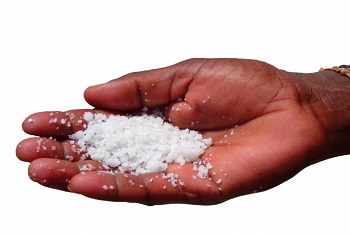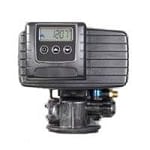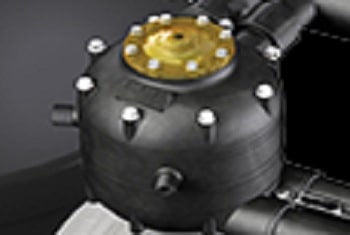As you check your water softener brine tank, you notice that the water in the tank looks quite dirty. It even has a dirty-looking froth on top of it. You have never thought about if you have to clean your brine tank, but should a water softener brine tank be cleaned?
Dirty water in your water softener brine tank does not mean that it needs to be cleaned immediately. The brine is used by your water softener and then it is rinsed away with clean water. Some dirt in your brine will not affect the regeneration of your water-softener resin.
Although it is not hard to clean a water softener brine tank, there are only a few reasons why you should clean your water softener brine tank.
How your water softener brine tank gets dirty and when should you clean it?
Much of the dirt that you see in your brine tank is from the salt that you have put into the tank. Before the salt gets into a bag, it was mined from the earth and some dirt from mining the salt gets into the bag along with the salt.

On older water softeners and some of the more basic systems, the water that goes into the brine tank is untreated by the water softener itself so iron and debris that could be in your water will end up in your brine tank.
Many newer water softeners use softened water to fill the brine tank so the water entering the brine tank is soft and iron-free.
Because the brine in a water softener brine tank is only used to regenerate the water softener resin in your water softener, your brine tank does not need to be cleaned very often.
But, cleaning your water softener brine tank occasionally is a wise idea to keep your water softener working properly, and keep the resin in your water softener working as efficiently as possible.
Can dirt in my brine tank damage my water softener?
Anytime that dirt or debris comes into contact with a mechanical device there can be problems, but when the brine from a water softener brine tank gets drawn into a standard electric water softener it makes very little contact with any moving parts.
When the brine goes through the water softener valve, the water is flowing through an opening that is far too large for a little spec of dirt to have much of an effect and a little bit of dirt in the brine will simply flow through the water softener resin and then go out through the drain line.
Will dirt in my brine tank hurt my “Electric” water softener?

The only potential problem that would commonly occur with dirty brine going through an electric water softener would be for some of the dirt to get lodged in the water softener injector which creates the draw that pulls the brine from the brine tank.
When the injector of a water softener becomes clogged, it may not draw all of the brine from the brine tank leaving the brine tank full of water.
For the most part, dirty brine in the brine tank of an electric water softener will have little effect on the water softener’s performance and there is only a need to clean the brine tank if it becomes so dirty that the dirt sticks to the walls of the brine tank where it could clump together and become large enough to create a clog in the water softener valve.
Dirty brine can be a problem for a “Non-electric” water softener!

A non-electric water softener usually relies on a single rubber seal to shut off the water going into the brine tank, and even a small particle of dirt could cause the seal to not seal completely which will result in the water softener continuing to fill the brine tank and cause it to overflow.
This is why I always highly recommend using a water pre-filter before a non-electric water softener to remove dirt from your water that could get lodged in the shut-off seal and overflow the brine tank.
I also recommend using the cleanest salt that you can for your non-electric water softener.
Most water softener salt that you will find at your local hardware store will work fine in a non-electric water softener, but for keeping your brine tank clean, pellet salt is a processed salt that contains virtually no dirt or debris in it.
The only downside to using pellet salt in your non-electric water softener is that the salt is shaped into the pellet shape using a binder that does not dissolve in water.
After the salt part of the pellet gets dissolved, the binder settles to the bottom of the brine tank and stays there until it is removed by hand. Quick cleaning of the bottom of the brine tank with a shop vac to remove this settled binder works well to keep it from building up over time.
How often should I clean my water softener brine tank?
Most water softener manufacturers recommend that you clean your water softener brine tank once a year to prevent excessive build-up of dirt and debris in the tank and to ensure that your water softener resin gets a proper dose of brine during the regeneration process.
Of course, how often you should clean your brine tank will depend on how much water you use in your home, how often your water softener needs to regenerate, and what type of salt you use for your water softener.
A single person using clean pellet salt in a water softener may never need to clean their brine tank at all.
But a family of four or more using salt crystals that will contain more dirt in it with a water softener that needs to regenerate daily will naturally accumulate more dirt in the brine tank and will need to be cleaned more often.
Can I use bleach to clean my water softener brine tank?
If you clean your brine tank frequently, just using a mix of about 1 tablespoon of dish detergent to one gallon of clean warm water will normally do a fine job of wiping down the walls and bottom of the brine tank.
But if you find that mold has begun to grow on the walls of your brine tank, using a little bleach and water will make cleaning easier.
If you do choose to use bleach to clean your brine tank, rinse the tank with clean water after cleaning it, and don’t forget to clean any bleach off the outside of the brine tank to prevent the bleach from getting on nearby items.
How to clean your water softener brine tank. Step-by-step!
Wait until the salt in your brine tank goes down to nearly empty to avoid having to remove the extra salt in the brine tank.
1. Put your water softener into “Bypass Mode” so there will no longer be any water flowing into your water softener or brine tank. There are several different ways that a water softener may be bypassed, check your owner’s manual to find out how to bypass your particular make and model of the water softener.
2. Disconnect the brine tube and drain tube (if you have a drain tube) from your brine tank. This should be very easy as many water softeners use a quick disconnect connector for the brine line. To disconnect the tube from the quick disconnect connector, push the tubing into the quick disconnect fitting and then hold the grab ring back while you pull the tubing out.
3. Using a shop vac or a hose to siphon the remaining brine out of the brine tank, dispose of the old brine in a location where it will no harm and plants, flowers, or grass. Dispose of the brine down a drain or in a graveled area.
4. Once you have removed as much of the salt and brine that you can, tip the brine tank on its side in an area that is free of plants, flowers, or grass, and use some clean water to rinse out any remaining salt and brine.
Removing excess salt from your brine tank.
5. If there are any large clumps of salt remaining in the brine tank, you can use some warm water to help dissolve them away or break them apart for removal.
6. At the bottom of your brine tank, you may see a white (it might be yellow because it is dirty) grid plate that works as a screen to keep the salt and debris above the bottom of the brine float assembly to prevent debris from getting drawn up the brine line. Remove this grid plate by simply pulling it up and out of the tank.
Cleaning solution for your brine tank.
7. Use a mixture of about 2 tablespoons of dish soap to 2 gallons of clean water to clean the inside of the tank and the grid plate. Pour the soapy mixture into the tank and use a soft bristle brush or a small broom to scrub the inside of the tank.
8. Pour out the soapy mixture and rinse the inside of the tank thoroughly with clean water.
9. If you choose to use bleach to clean your brine tank, pour a mixture of 1/4 cup unscented household bleach to 3 gallons of clean water into the tank and stir the mixture around, then let the bleach mixture sit for 15 – 30 minutes.
10. Pour out the bleach mixture and rinse the tank thoroughly with clean water.
11. Replace the grid plate if your water softener has one and put the brine tank back where it belongs. Be sure the floor where the brine tank sits is clear of debris.
12. Reconnect the brine tubing and drain tubing to the brine tank and add 5 gallons of clean water into the brine tank.
13. Take your water softener out of “Bypass Mode” and add a minimum of (2) 40-50 pound bags of water softener salt into the tank. Do NOT overfill the brine tank with salt. Only fill the brine tank with salt to about 6 inches from the top.
The salt should sit in the water for several hours to create brine before it is used to regenerate the water-softener resin.
14. After 3-4 hours, you can regenerate your water softener if you need to or simply let it regenerate as needed. And you are done!
To sum up.
Cleaning your water softener brine tank is a good idea if you notice that the water in the tank is very dirty and after you have cleaned it a few times, it will seem quick and easy.
If you notice a little dirt in your water softener’s brine tank, don’t worry. That water is being used to regenerate the resin in your water softener and is not flowing into your drinking water.
Using very pure water softener “Solar Salt” or “Pellet Salt” will keep your brine tank cleaner, but they do tend to cost more. Choose which salt you would like to use, and clean your brine tank as you see needed.


I have a very old system that uses a grid plate that looks like it is just pegboard that was cut up into the 18″ round shape with the 4″ hole in it for the float tube. It hadn’t been cleaned in a LONG time and I found that a long of salt “mush” was covering the plate and underneathe it. Took some doing to get it out and the plate supports are damaged. They are the same “pegboard” mounted in a criss-cross pattern. Only 1 remained intact. The plate support height is about 3″ before the round plate goes on. I see mentioning of 4″ on the plastic type plates one can buy. Since I need to go to Florida soon, I didn’t think I have the time to wait for grid and went to Home Depot & got some vinyl “trim” that I cut up the same way the original grid was done (looks like a tic-tac-do grid). Trouble is this plate is 2.5 ” high. I can make some pvc pipe legs to raise it higher.
2 questions :
1. Is this old grid actually simple pegboard or is it special material (or treated) so it don’t rot in the water?
I would think regular pegboard would decompose.
2. is it height of 3″ that it had important that my home made grid must match it or be even the 4″ height. Worked well all these years at 3″. The loss of .5″ a deal breaker ?
Thanks. enjoyed your steps to clean info.
Could ad that using an electric power washer helps clean the tank, if you wear googles so salty water don’t nail you in the face on splash-back LOL.
Mike.
Hello Mike and thank you for the questions.
The grid plate at the bottom of a water softener brine tank is normally made of plastic but an old grid plate may look like a peg board due to being discolored over the years.
The height of the plate is to prevent salt crystals and debris from getting drawn into the water softener brine tube.
The height of the plate also will affect the salt dosage that the water softener receives but if your new plate is close to the original height, it shouldn’t be a problem.
Nice idea about the power washer as long as you protect yourself and the area around the tank, it could get quite messy. I use a regular hose sprayer so I can regulate the water pressure.
I hope this was helpful.
Paul